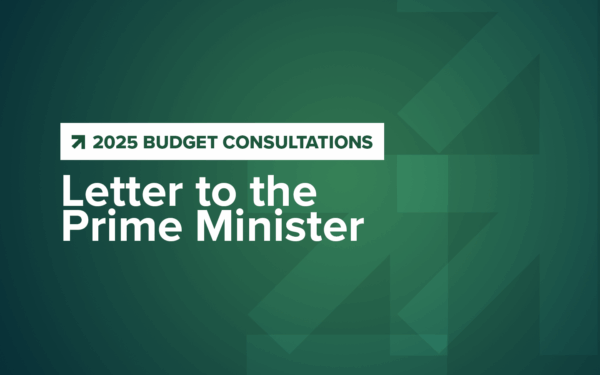Framing an energy strategy for Canada
Submission to the Council of the Federation
At the July 2012 meeting of the Council of the Federation, Canada’s Premiers should build on their 2007 statement, A Shared Energy Vision for Canada, and commit to a broad vision for Canadian energy, as well as agree on a short list of priority items.
Our view of a Canadian energy strategy begins with a common vision for the country. It would recognize our vast and diverse energy resources as a key enabler of Canadian economic development. It would engage not just those who develop and supply energy, but also the users of all forms of energy across the country – businesses, public institutions, farmers and Canadian consumers.
An encompassing vision is one in which all regions see their energy circumstances and interests adequately reflected. But rather than seeing the wide array of energy assets and sometimes varying regional and sectoral aspirations as an obstacle, we should embrace the opportunity to build regional interests into a coherent whole, thereby strengthening the federation.
The tremendous potential of our energy assets also provides an opportunity and a responsibility to develop a vision of Canada as a leader in the development of sustainable energy for the longer term. This includes not only the ability to tap into a wider array of affordable energy for domestic use, but also a greater role in developing and deploying innovative technologies that can enhance access around the globe to cleaner energy sources and environmentally advanced solutions.
In turning that vision into an effective strategy for the country, we envisage 10 key elements:
1. Enhance the Canadian brand
In an increasingly interconnected world, national brand recognition is important, especially for a middle power such as Canada. The country has an historic opportunity to solidify its reputation as a responsible and reliable supplier of a wide variety of energy to international markets. Critical to this is ensuring that governments, industry and other stakeholders are on the same page when it comes to presenting Canada’s strengths to the world.
Part of our reputation has and should continue to stem from Canada’s continued adherence to rules- and market-based energy policy, in a world where increasingly energy resources are under state control. In addition, our history of welcoming foreign investment, and of maintaining open flows of trade in energy, will continue to serve us well.
There is an important opportunity for our energy industry to become much better identified with a commitment to innovation, as well as for ongoing efforts to improve product performance, efficiency and environmental effectiveness. Canadian enterprises can play a larger role in the development, refinement, adaptation and dissemination of leading-edge technologies, and be growing suppliers of products, know-how and related services to firms and markets around the world.
We also need to ensure that the country’s environmental policies are viewed outside our borders as effective and of a high standard. In particular, given the world wide attention to the risks of climate change, we need national alignment on an effective carbon management regime that reflects Canada’s full commitment to long-term greenhouse gas mitigation.
2. Strengthen energy literacy, build a culture of energy conservation and facilitate informed consumer choice
In a major policy paper last year, the Council outlined its views with respect to the importance of engaging all Canadians in much greater efforts to conserve energy. We must use existing and future energy supplies as efficiently as possible, embracing the maxim that the cheapest form of energy is the unit that is not used. Better conservation practices will help to insulate Canadians from volatile energy prices, reduce costs for public institutions such as schools and hospitals, and improve the international competitiveness of Canadian companies.
More efficient energy use would bring other benefits to society as well. Reduced use of carbon-based fuels would make urban air more breathable. Smart transportation choices would diminish traffic congestion and improve workplace productivity. And better urban design would make cities more livable and help Canadians achieve a better work-life balance.
Key to realizing these benefits is fostering a much higher degree of energy literacy among Canadians. And here the provinces have many of the key tools. In particular, Premiers should give direction to their energy and education ministers to establish a national energy literacy program. Working with industry and public-spirited groups, they can reinforce best practices and build on leading-edge programs on conservation and efficiency.
Provinces also should work with the federal government to lead a rational and informed debate on Canada’s energy choices. Canadians need to understand that all energy choices have impacts, and it is about making appropriate choices with knowledge of the facts and fair consideration of effective means to limit potential negative impacts. This is the best means to ensure Canadians have access to smart energy choices, affordable prices and
reliable energy services. The broader Canadian public also needs to understand the benefits of continued diversification of Canada’s energy portfolio, allowing us to respond in a timely and effective manner to changing economic and technological developments.
Above all, governments should resist the temptation to shield consumers from the true cost of energy. Prices tend to influence individuals’ behaviour in a way that public exhortation and appeals to the greater good do not. Canadians – as business owners, farmers, building managers and individual consumers – need to see the everyday cost of inefficient use of energy and be motivated to change their energy consumption patterns and investment decisions.
3. Build greater North American energy self-sufficiency
Like Canada, the rest of North America is blessed with an abundance of energy resources, both fossil fuels and some of the best renewable resources in the world. Recent discoveries of additional oil and gas resources, the development of new production technologies, improvements in the cost effectiveness of renewables and an ongoing commitment to energy efficiency have meant that there is potential for Canada, the United States and Mexico working together to be much more self-sufficient in energy. Lessening dependence on foreign sources of energy not only bolsters energy security and economic prosperity, it also will make us less reliant on unstable and unfriendly regimes and less susceptible to price volatility. And strengthening continental energy relationships will create tremendous spinoff benefits for North American firms in manufacturing, materials, financial services and technology application.
A priority should be the strengthening of cross-border energy infrastructure, including expansion of pipelines, distribution systems and smart electricity grids. To that end, approval processes need to be streamlined to make them more predictable and timely. There also are opportunities to expand on current technology cooperation arrangements between countries, aimed particularly at increased energy efficiency, the expanded use of lower-carbon energy and reducing environmental impacts from energy production and consumption. Examples of the latter include carbon capture and storage, biofuels and alternative energy, and advanced vehicles.
There also is much greater opportunity for continental regulatory coherence across energy and environmental domains, especially given highly integrated supply chains. The Regulatory Cooperation Council is an important step but Canada should be doing more to ensure regulatory standards do not impede continental efforts to build a cleaner energy mix.
One important area for further coordination involves climate change and carbon policy. We already have seen the logic of setting standards for vehicles, fuels and appliances on a North American basis. Similarly, we need to ensure that energy-intensive and trade-exposed industry sectors in Canada do not face GHG compliance costs that are disproportionate relative to their competitors to the south.
Even within our borders, we need to be constantly attuned to the opportunity to further diversify supply to our domestic energy markets. It is encouraging to see Canadian companies exploring the potential to bring more Western Canadian crude to Eastern Canadian markets. More fundamentally, we should be taking better advantage of the country’s incredibly diverse array of energy resources, which include oil and gas, coal,
uranium/nuclear, hydro, biofuels, wind, solar, geothermal and tidal power.
Finding economic ways to expand our supply of the full range of domestic energy resources will further enhance their economic benefit to the country, while supporting competitive Canadian industries and well-paying jobs.
4. Diversify energy markets
Canada has achieved enormous economic benefits from our close proximity to the most dynamic economy in the world, bolstered by enhanced trade agreements and the development of tightly integrated supply chains. Nowhere has that advantage been more obvious than with respect to energy, which is now our most valuable export to the United States.
Recent events have demonstrated, however, that overreliance on a single market can have disadvantages. Excess supply and bottleneck in the US midwest pipeline system mean that oil from Western Canada trades at a discount as high as $30 compared to world prices. The “shale gas revolution” has greatly increased continental supply and natural gas prices have fallen to near $2 per mcf in North America, compared to prices in Europe and Asia that recently have been three to six times higher.
Canada’s most important new export market is in Asia, where fast-growing economies and the people’s desire for access to modern energy services and rising standards of living are fueling demand for the kinds of energy that Canada has in abundance. Energy can be an important lever in the Canada-Asia relationship, helping us to achieve our economic and diplomatic goals in the region.
At the same time, many other countries are recognizing this tilt toward Asia in terms of global economic and geopolitical importance. And other energy exporting nations are eager to compete to take advantage of Asia’s energy appetite. This reinforces the need to develop sound infrastructure and efficient regulatory processes to demonstrate to foreign markets that we can be a reliable supplier of energy.
5. Invest in sound energy infrastructure
Recent estimates suggest as much as $300 billion of investment will be needed in Canada over the next two decades to sustain and strengthen energy infrastructure. Much of the existing infrastructure is in need of refurbishment/upgrading, but also new transmission systems and pipelines will be required to enhance regional interconnections and expand export opportunities.
In particular, Premiers should focus on greater regional cooperation to enable infrastructure solutions that take advantage of regional energy assets and meet the specific needs of their populations. Through improving reliability and expanding access to a broader array of both traditional and renewable energy, governments should seek to ensure affordable energy for consumers and a stronger competitive position for Canadian industry.
Investments in infrastructure also are essential to enable Canada to access new markets for its energy products. Both the federal and affected provincial governments should work together with industry to examine the potential for multiple energy corridors to the Pacific, in the interests of expanding exports to growing Asian markets.
6. Create a Canadian energy technology advantage
Growing world energy demand brings not only the opportunity for expanding our share of bulk energy exports. Cleaner technologies related to energy, as well as related services and expertise, will be in high demand as growing populations in many parts of the world seek modern energy services with lower environmental and social impact. The competition to provide next-generation technologies is already proving to be fierce, and Canada cannot be left out of the game. As a country, we strive to develop the most supportive public policy framework to spur development and deployment of sounder energy technologies.
The Canadian energy industry already is working with governments, researchers and other partners on next-generation technology development. But more needs to be done to foster effective collaboration among the
private sector, governments and academia, and to ensure non-private sector research fits the needs of Canadian companies.
Clearly, not all of the innovation will happen in Canada, but there is more to be done in establishing cutting-edge laboratories and formulating practical policies that support expanded private sector R&D. One critical issue, not
unique to the energy sphere, is how to get beyond the development and demonstration of advanced technologies to full-scale commercialization.
There also is a need to think about infrastructure that could support advanced transportation technologies – such as biofuels, natural gas and hydrogen – as well as the potential to create a Canadian advantage in the growing field of energy storage technology.
The energy industry also needs to upgrade its commitment to research and development of energy technologies. One promising initiative is the launch of the Canadian Oil Sands Innovation Alliance (COSIA), a consortium of 12
leading companies engaged in oil sands development. COSIA will pool industry efforts toward technology development and deployment aimed at developing solutions to the industry’s most pressing environmental
challenges. Efforts of this sort are critical, since they will help solidify Canada’s reputation as a developer of sustainable energy solutions, but also because innovation inside the energy industry can spur new levels of
innovation outside it.
7. Ensure efficient regulatory processes
The World Economic Forum has identified “inefficient government bureaucracy” as one of the key impediments to doing business in Canada. Our federal system can sometimes compound our disadvantage, which is why we need to set a goal of an innovative, modern and reformed regulatory system that is a comparative advantage for Canada. When it comes to the approval process for major energy projects, an inefficient regulatory system can easily frustrate efforts to enhance Canadian prosperity, as well as limit Canadians’ access to sounder energy choices and affordable energy with lower environmental impact.
The federal government’s announcement of its “Responsible Resource Development” initiative is a significant step towards the reform that has been promised for several years by both levels of government. It has a number of important elements:
- Establishing appropriate timelines for decision-making to increase timeliness and predictability;
- Clarifying responsibility among the myriad federal departments and centralizing and simplifying the decision-making process;
- Specifying the types of major projects that require formal federal assessment and those for which an equivalent provincial process can be substituted;
- Clarifying what issues are for assessment by the appropriate regulatory body with respect to the individual project, and what issues are the prerogative of government as the key decision-maker with respect to the overall public interest;
- Streamlining the intervenor process so that all legitimate points of view can be heard, but avoiding duplication and delays that do not enhance the final decision.
The problem of overlapping departmental responsibilities also is an issue within several provinces. By simplifying and clarifying their own approval processes, provinces and territories can help to realize the long-stated goal of “one project, one review”. With its recent reform proposals, the federal government appears willing; now it is time for the provinces and territories to do their part.
For its part, industry should work with governments to ensure regulatory processes related to major energy developments can engage affected stakeholders in an appropriate and effective manner while also making the
overall process more timely and predictable.
8. Facilitate stronger partnerships with Aboriginal peoples on energy projects
The opportunities for Canada’s First Nations, Inuit, and Métis in broader resource development are obvious if not always fully appreciated. Many of Canada’s richest resource and energy assets are found near Aboriginal communities. This in turn can create spin-off economic benefits, employment opportunities and a better skilled workforce, which contribute to more resilient communities. But Aboriginal communities also have legitimate concerns about major resource expansion, including implications for land claims, the impact on their communities and way of life, as well as on the land, air and water around them.
At one level, this will take a renewed and purposeful commitment from governments and Aboriginal leaders. One priority is to ensure government authorities responsible for education work with the business community and Aboriginal representatives to design a tripartite solution to combating the related problems of underemployment of Aboriginal youth and current labour shortages. This would represent a large step forward in making Aboriginal communities true partners as well as demonstrating a commitment to making the next generation of Aboriginal peoples a national priority.
Addressing the role of Aboriginal communities in energy and resource development begins with early engagement and a true spirit of building stronger relationships. It also requires new thinking on the process, scope and funding of consultation and engagement. There is no one-size-fits-all approach when it comes to the large array of resource development projects and the number of distinctive Aboriginal communities. Yet we can learn from best practices currently being undertaken in some development projects and seek to employ them more broadly as appropriate.
Some Aboriginal communities have entered into Impact and Benefit Agreements (IBAs) with resource companies to secure broader benefits from such projects. A number of approaches have been used, including revenue sharing, minority equity interests and full partnership. As well, a large number of Aboriginal-owned businesses have grown up to service the needs of resource projects in more remote parts of the country.
As more and more companies are discovering, business has a reason to invest in capacity-building in Aboriginal communities. They can help to provide the financial tools and business acumen that can assist these communities in realizing the benefits of economic development, as well as participate in training the Aboriginal work force of the future. Better employment prospects are key, as Aboriginal youth is the fastest growing segment of the Canadian population and yet currently they face chronic underemployment challenges.
9. Facilitate a coherent national climate policy
Discussion of Canada’s energy opportunity has to be undertaken with full recognition of the environmental consequences of energy development and use. One clear priority is addressing the risks of climate change.
Unfortunately, we are still in a world of conflicting plans and obligations, with multiple plans and objectives among the federal and various provincial/territorial governments.
Alberta, British Columbia and Quebec each have instituted a form of carbon pricing. As well, the federal government currently is developing a series of sector-specific regulations for GHG performance in key industrial sectors. However, these steps do not address the full range of GHG emissions across Canadian society that must be mitigated in order to meet the ambitious targets that many governments have set. As well, they leave firms across the country facing potentially conflicting obligations. We believe that provincial and territorial governments should take the lead in bringing more coherence to climate policy across the country. Otherwise, we risk poor citizen engagement and wasted resources, not to mention hobbling Canadian firms at the very time they need to be investing in the innovative technologies that are key to long-term and sustainable reductions in greenhouse gas
emissions.
Our recommendations with respect to carbon policy have been outlined in previous statements.
3 Key principles include:
- A clear, nationally consistent carbon price across the economy;
- Start at relatively low levels so as to give time for adjustment and to avoid unnecessary impacts on competitiveness;
- Revenue raised should fund reductions in other taxes, both to assist vulnerable consumers and to support the competitiveness of Canadian industry, as well as a portion devoted to the development of new technologies;
- Revenue distribution should be designed to avoid an undue cost burden on any particular region or sector;
- Transparent costs to Canadians are essential to stimulate smart consumer energy choices.
10. Build an integrated labour force strategy
One of the greatest threats to Canada’s ability to take full advantage of our energy resources is the reality that our current labour force does not have the skills and capabilities that will be needed to turn many of these resources into economic assets. Estimates suggest that the petroleum sector alone is at risk of not meeting 36 percent of its net hiring requirements over the next three years. And it is becoming readily apparent that many skill categories will experience shortages as older workers retire. Nor is this problem unique to the energy sector. Already companies in various sectors are bringing in skilled workers from other countries. Recently proposed changes to the immigration system – the proposed expansion of the temporary foreign workers program and the new emphasis on attracting
immigrants with the requisite skills – will help.
These changes are more short-term in nature; the real problem clearly is systemic as it relates to the mismatch between the jobs of the next decade and the educational qualifications of current Canadian graduates. Energy
and resource projects depend disproportionately on employees with qualifications in engineering, science, technology and the skilled trades. Yet it has been obvious for some time that the country lacks sufficient numbers
of qualified graduates to meet current, let alone future, demand. This ongoing imbalance will not only curtail the country’s ability to take full advantage of its resource development potential, it also will limit the ability of many young Canadians to find satisfying and sustainable careers and healthy incomes.
It seems clear that this challenge will require a diversity of solutions, including: improvements to education; better workforce development through apprenticeships and other programs; further immigration reforms (both temporary and permanent); programs to foster worker mobility; and enhanced labour force participation by under-represented groups, The CCCE will be addressing these and other important labour market challenges in a future work program, and will have more detailed recommendations at that time. In the meantime, we urge the provinces, which have primary responsibility for education, to work with the private sector to ensure that educational attainment and job needs of the future are much more closely aligned.
WHAT WE WANT PREMIERS TO DO
- Reinforce and reinvigorate the energy strategy developed by the Council of the Federation in 2007 and update it with an agreement on the essential elements of a Canadian energy vision.
- Pursue a “whole of government” approach within their jurisdictions, recognizing energy as a key enabler of economic development, job creation, innovation and social progress.
- Reinforce with their citizens the importance of energy to generating economic prosperity in all regions of the country.
- Engage energy and education ministers in a national energy literacy program.
- Spearhead efforts toward a much more coherent climate policy for Canada.
- Ensure energy ministers implement the commitments made last year in Kananaskis to streamline the regulatory system.
- Report yearly on progress in realizing the Canadian energy vision.












